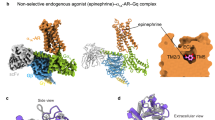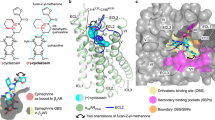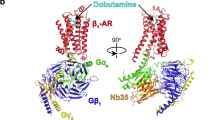Abstract
β-adrenergic receptors (βARs) are G-protein-coupled receptors (GPCRs) that activate intracellular G proteins upon binding catecholamine agonist ligands such as adrenaline and noradrenaline1,2. Synthetic ligands have been developed that either activate or inhibit βARs for the treatment of asthma, hypertension or cardiac dysfunction. These ligands are classified as either full agonists, partial agonists or antagonists, depending on whether the cellular response is similar to that of the native ligand, reduced or inhibited, respectively. However, the structural basis for these different ligand efficacies is unknown. Here we present four crystal structures of the thermostabilized turkey (Meleagris gallopavo) β1-adrenergic receptor (β1AR-m23) bound to the full agonists carmoterol and isoprenaline and the partial agonists salbutamol and dobutamine. In each case, agonist binding induces a 1 Å contraction of the catecholamine-binding pocket relative to the antagonist bound receptor. Full agonists can form hydrogen bonds with two conserved serine residues in transmembrane helix 5 (Ser5.42 and Ser5.46), but partial agonists only interact with Ser5.42 (superscripts refer to Ballesteros–Weinstein numbering3). The structures provide an understanding of the pharmacological differences between different ligand classes, illuminating how GPCRs function and providing a solid foundation for the structure-based design of novel ligands with predictable efficacies.
This is a preview of subscription content, access via your institution
Access options
Subscribe to this journal
Receive 51 print issues and online access
$199.00 per year
only $3.90 per issue
Buy this article
- Purchase on Springer Link
- Instant access to full article PDF
Prices may be subject to local taxes which are calculated during checkout




Similar content being viewed by others
Accession codes
References
Evans, B. A. et al. Ligand-directed signalling at β-adrenoceptors. Br. J. Pharmacol. 159, 1022–1038 (2010)
Rosenbaum, D. M., Rasmussen, S. G. & Kobilka, B. K. The structure and function of G-protein-coupled receptors. Nature 459, 356–363 (2009)
Ballesteros, J. A. & Weinstein, H. Integrated methods for the construction of three dimensional models and computational probing of structure function relations in G protein-coupled receptors. Methods Neurosci. 25, 366–428 (1995)
Strader, C. D. et al. Conserved aspartic acid residues 79 and 113 of the β-adrenergic receptor have different roles in receptor function. J. Biol. Chem. 263, 10267–10271 (1988)
Sato, T., Kobayashi, H., Nagao, T. & Kurose, H. Ser203 as well as Ser204 and Ser207 in fifth transmembrane domain of the human β2-adrenoceptor contributes to agonist binding and receptor activation. Br. J. Pharmacol. 128, 272–274 (1999)
Liapakis, G. et al. The forgotten serine. A critical role for Ser-2035.42 in ligand binding to and activation of the β2-adrenergic receptor. J. Biol. Chem. 275, 37779–37788 (2000)
Strader, C. D. et al. Identification of two serine residues involved in agonist activation of the beta-adrenergic receptor. J. Biol. Chem. 264, 13572–13578 (1989)
Wieland, K. et al. Involvement of Asn-293 in stereospecific agonist recognition and in activation of the beta 2-adrenergic receptor. Proc. Natl Acad. Sci. USA 93, 9276–9281 (1996)
Suryanarayana, S. & Kobilka, B. K. Amino acid substitutions at position 312 in the seventh hydrophobic segment of the beta 2-adrenergic receptor modify ligand-binding specificity. Mol. Pharmacol. 44, 111–114 (1993)
Kikkawa, H., Isogaya, M., Nagao, T. & Kurose, H. The role of the seventh transmembrane region in high affinity binding of a β2-selective agonist TA-2005. Mol. Pharmacol. 53, 128–134 (1998)
Isogaya, M. et al. Identification of a key amino acid of the β2-adrenergic receptor for high affinity binding of salmeterol. Mol. Pharmacol. 54, 616–622 (1998)
Cherezov, V. et al. High-resolution crystal structure of an engineered human β2-adrenergic G protein-coupled receptor. Science 318, 1258–1265 (2007)
Warne, T. et al. Structure of a β1-adrenergic G-protein-coupled receptor. Nature 454, 486–491 (2008)
Hanson, M. A. et al. A specific cholesterol binding site is established by the 2.8 Å structure of the human β2-adrenergic receptor. Structure 16, 897–905 (2008)
Wacker, D. et al. Conserved binding mode of human β2 adrenergic receptor inverse agonists and antagonist revealed by X-ray crystallography. J. Am. Chem. Soc. 132, 11443–11445 (2010)
Tate, C. G. & Schertler, G. F. Engineering G protein-coupled receptors to facilitate their structure determination. Curr. Opin. Struct. Biol. 19, 386–395 (2009)
Kobilka, B. K. & Deupi, X. Conformational complexity of G-protein-coupled receptors. Trends Pharmacol. Sci. 28, 397–406 (2007)
Park, J. H. et al. Crystal structure of the ligand-free G-protein-coupled receptor opsin. Nature 454, 183–187 (2008)
Scheerer, P. et al. Crystal structure of opsin in its G-protein-interacting conformation. Nature 455, 497–502 (2008)
Engelhardt, S., Grimmer, Y., Fan, G. H. & Lohse, M. J. Constitutive activity of the human β1-adrenergic receptor in β1-receptor transgenic mice. Mol. Pharmacol. 60, 712–717 (2001)
Green, S. A., Rathz, D. A., Schuster, A. J. & Liggett, S. B. The Ile164 β2-adrenoceptor polymorphism alters salmeterol exosite binding and conventional agonist coupling to Gs . Eur. J. Pharmacol. 411, 141–147 (2001)
Piscione, F. et al. Effects of Ile164 polymorphism of beta2-adrenergic receptor gene on coronary artery disease. J. Am. Coll. Cardiol. 52, 1381–1388 (2008)
Serrano-Vega, M. J. & Tate, C. G. Transferability of thermostabilizing mutations between β-adrenergic receptors. Mol. Membr. Biol. 26, 385–396 (2009)
Serrano-Vega, M. J., Magnani, F., Shibata, Y. & Tate, C. G. Conformational thermostabilization of the β1-adrenergic receptor in a detergent-resistant form. Proc. Natl Acad. Sci. USA 105, 877–882 (2008)
Balaraman, G. S., Bhattacharya, S. & Nagarajan, V. Structural insights into conformational stability of wild-type and mutant β1-adrenergic receptor. Biophys. J. 99, 568–577 (2010)
Altenbach, C. et al. High-resolution distance mapping in rhodopsin reveals the pattern of helix movement due to activation. Proc. Natl Acad. Sci. USA 105, 7439–7444 (2008)
Rasmussen, S. G. et al. Crystal structure of the human β2 adrenergic G-protein-coupled receptor. Nature 450, 383–387 (2007)
Williams, R. S. & Bishop, T. Selectivity of dobutamine for adrenergic receptor subtypes: in vitro analysis by radioligand binding. J. Clin. Invest. 67, 1703–1711 (1981)
Katritch, V. et al. Analysis of full and partial agonists binding to β2-adrenergic receptor suggests a role of transmembrane helix V in agonist-specific conformational changes. J. Mol. Recognit. 22, 307–318 (2009)
Warne, T., Serrano-Vega, M. J., Tate, C. G. & Schertler, G. F. Development and crystallization of a minimal thermostabilised G protein-coupled receptor. Protein Expr. Purif. 65, 204–213 (2009)
Leslie, A. G. W. The integration of macromolecular diffraction data. Acta Crystallogr. D 62, 48–57 (2006)
Evans, P. Scaling and assessment of data quality. Acta Crystallogr. D 62, 72–82 (2006)
McCoy, A. J. et al. Phaser crystallographic software. J. Appl. Cryst. 40, 658–674 (2007)
Murshudov, G. N., Vagin, A. A. & Dodson, E. J. Refinement of macromolecular structures by the maximum-likelihood method. Acta Crystallogr. D 53, 240–255 (1997)
Emsley, P., Lohkamp, B., Scott, W. G. & Cowtan, K. Features and development of Coot . Acta Crystallogr. D 66, 486–501 (2010)
Schüttelkopf, A. W. & van Aalten, D. M. PRODRG: a tool for high-throughput crystallography of protein-ligand complexes. Acta Crystallogr. D 60, 1355–1363 (2004)
McDonald, I. K. & Thornton, J. M. Satisfying hydrogen bonding potential in proteins. J. Mol. Biol. 238, 777–793 (1994)
Jones, T. A., Zou, J. Y., Cowan, S. W. & Kjeldgaard, M. Improved methods for building protein models in electron-density maps and the location of errors in these models. Acta Crystallogr. A 47, 110–119 (1991)
Davis, I. W. et al. MolProbity: all-atom contacts and structure validation for proteins and nucleic acids. Nucleic Acids Res. 35, W375–W383 (2007)
Baker, J. G., Hall, I. P. & Hill, S. J. Agonist actions of “β-blockers” provide evidence for two agonist activation sites or conformations of the human β1-adrenoceptor. Mol. Pharmacol. 63, 1312–1321 (2003)
Warne, T., Chirnside, J. & Schertler, G. F. Expression and purification of truncated, non-glycosylated turkey beta-adrenergic receptors for crystallization. Biochim. Biophys. Acta 1610, 133–140 (2003)
Cheng, Y.-C. & Prusoff, W. H. Relationship between the inhibition constant (K I ) and the concentration of inhibitor which causes 50 per cent inhibition (I 50) of an enzymatic reaction. Biochem. Pharmacol. 22, 3099–3108 (1973)
Acknowledgements
This work was supported by core funding from the MRC and the BBSRC grant (BB/G003653/1). Financial support for G.F.X.S was also from a Human Frontier Science Project (HFSP) programme grant (RG/0052), a European Commission FP6 specific targeted research project (LSH-2003-1.1.0-1) and an ESRF long-term proposal. J.G.B. was funded by a Wellcome Trust Clinician Scientist Fellowship. We are grateful to P. Coli and A. Rizzi for the supply of (R,R)-carmoterol. F. Gorrec is thanked for his help with crystallisation robotics. We would also like to thank beamline staff at the European Synchrotron Radiation Facility, particularly D. Flot and A. Popov at ID23-2 and F. Marshall, M. Weir, M. Congreve and R. Henderson for comments on the manuscript.
Author information
Authors and Affiliations
Contributions
T.W. devised and performed receptor expression, purification, crystallization, cryo-cooling of the crystals, data collection and initial data processing. P.C.E. helped with crystal cryo-cooling and data collection. J.G.B. performed the pharmacological analyses on receptor mutants in whole cells and R.N. performed the ligand binding studies on baculovirus-expressed receptors. R.M. and A.G.W.L. were involved in data processing and structure refinement. Manuscript preparation was performed by T.W., C.G.T., A.G.W.L. and G.F.X.S. The overall project management was by G.F.X.S. and C.G.T.
Corresponding authors
Ethics declarations
Competing interests
The authors declare no competing financial interests.
Supplementary information
Supplementary Information
The file contains Supplementary Figures 1-8 with legends and Supplementary Tables 1-8. (PDF 3137 kb)
Rights and permissions
About this article
Cite this article
Warne, T., Moukhametzianov, R., Baker, J. et al. The structural basis for agonist and partial agonist action on a β1-adrenergic receptor. Nature 469, 241–244 (2011). https://doi.org/10.1038/nature09746
Received:
Accepted:
Published:
Issue Date:
DOI: https://doi.org/10.1038/nature09746
This article is cited by
-
Polyamine detergents tailored for native mass spectrometry studies of membrane proteins
Nature Communications (2023)
-
The dynamics of agonist-β2-adrenergic receptor activation induced by binding of GDP-bound Gs protein
Nature Chemistry (2023)
-
Enhanced peroxidase-like activity of 2(3), 9(10), 16(17), 23(24)-octamethoxyphthalocyanine modified CoFe LDH for a sensor array for reducing substances with catechol structure
Analytical and Bioanalytical Chemistry (2023)
-
Mass spectrometry captures biased signalling and allosteric modulation of a G-protein-coupled receptor
Nature Chemistry (2022)
-
Filling of a water-free void explains the allosteric regulation of the β1-adrenergic receptor by cholesterol
Nature Chemistry (2022)
Comments
By submitting a comment you agree to abide by our Terms and Community Guidelines. If you find something abusive or that does not comply with our terms or guidelines please flag it as inappropriate.



